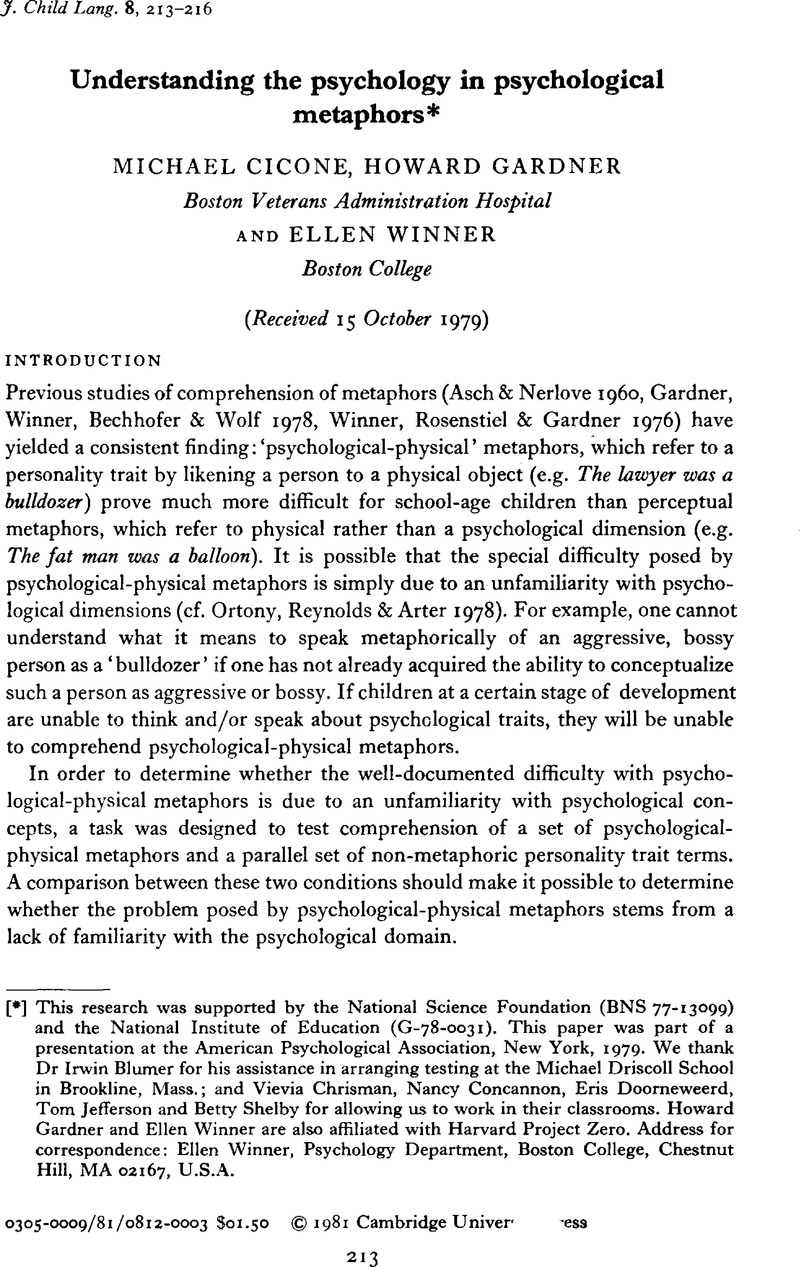Crossref Citations
This article has been cited by the following publications. This list is generated based on data provided by
Crossref.
Silberstein, Lisa
Gardner, Howard
Phelps, Erin
and
Winner, Ellen
1982.
Autumn leaves and old photographs: The development of metaphor preferences.
Journal of Experimental Child Psychology,
Vol. 34,
Issue. 1,
p.
135.
Voeniatou, Stella
1987.
Children and Metaphors.
Child Development,
Vol. 58,
Issue. 3,
p.
870.
Evans, Mary Ann
and
Gamble, Dianna Lynn
1988.
Attribute saliency and metaphor interpretation in school-age children.
Journal of Child Language,
Vol. 15,
Issue. 2,
p.
435.
Jones, Jacqueline
and
Stone, C. Addison
1989.
Metaphor Comprehension by Language Learning Disabled and Normally Achieving Adolescent Boys.
Learning Disability Quarterly,
Vol. 12,
Issue. 4,
p.
251.
Palermo, David S.
1989.
Advances in Child Development and Behavior Volume 21.
Vol. 21,
Issue. ,
p.
269.
Rothenberg, Albert
1990.
Creativity in Adolescence.
Psychiatric Clinics of North America,
Vol. 13,
Issue. 3,
p.
415.
Schecter, Barbara
and
Broughton, John
1991.
Developmental Relationships Between Psychological Metaphors and Concepts of Life and Consciousness.
Metaphor and Symbolic Activity,
Vol. 6,
Issue. 2,
p.
119.
Broderick, Victor
1991.
Young children's comprehension of similarities underlying metaphor.
Journal of Psycholinguistic Research,
Vol. 20,
Issue. 2,
p.
65.
Broderick, Victor
1992.
Incidence of verbal comparisons in beginners' books and in metaphor comprehension research: a search for ecological validity.
Journal of Child Language,
Vol. 19,
Issue. 1,
p.
183.
Seitz, Jay A.
1997.
The Development of Metaphoric Understanding: Implications for a Theory of Creativity.
Creativity Research Journal,
Vol. 10,
Issue. 4,
p.
347.
Castillo, Lisa C.
1998.
The effect of analogy instruction on young children's metaphor comprehension.
Roeper Review,
Vol. 21,
Issue. 1,
p.
27.
Wilson, Sandip Lee Anne
2000.
Review of Research: “A Metaphor is Pinning Air to the Wall”: A Literature Review of the Child's Use of Metaphor.
Childhood Education,
Vol. 77,
Issue. 2,
p.
96.
Seitz, Jay A.
2005.
The neural, evolutionary, developmental, and bodily basis of metaphor.
New Ideas in Psychology,
Vol. 23,
Issue. 2,
p.
74.
Özçalışkan, Seyda
and
Goldin-Meadow, Susan
2006.
Cognitive Linguistics: Current Applications and Future Perspectives.
p.
229.
Özçalışkan, ŞLeyda
2007.
Metaphors WeMove By: Children's Developing Understanding of Metaphorical Motion in Typologically Distinct Languages.
Metaphor and Symbol,
Vol. 22,
Issue. 2,
p.
147.
Waggoner, John E.
2010.
Temperature-Based Metonymies for Emotions in Children and Adults.
Psychological Reports,
Vol. 106,
Issue. 1,
p.
233.
Melogno, Sergio
D’Ardia, Caterina
Pinto, Maria Antonietta
and
Levi, Gabriel
2012.
Metaphor comprehension in autistic spectrum disorders: Case studies of two high-functioning children.
Child Language Teaching and Therapy,
Vol. 28,
Issue. 2,
p.
177.
Melogno, Sergio
Pinto, Maria Antonietta
and
Levi, Gabriel
2012.
Metaphor and metonymy in ASD children: A critical review from a developmental perspective.
Research in Autism Spectrum Disorders,
Vol. 6,
Issue. 4,
p.
1289.
Melogno, Sergio
D’Ardia, Caterina
Pinto, Maria Antonietta
and
Levi, Gabriel
2012.
Explaining metaphors in high-functioning Autism Spectrum Disorder children: A brief report.
Research in Autism Spectrum Disorders,
Vol. 6,
Issue. 2,
p.
683.
Stites, Lauren J.
and
Özçalışkan, Şeyda
2013.
Teasing Apart the Role of Cognitive and Verbal Factors in Children's Early Metaphorical Abilities.
Metaphor and Symbol,
Vol. 28,
Issue. 2,
p.
116.
